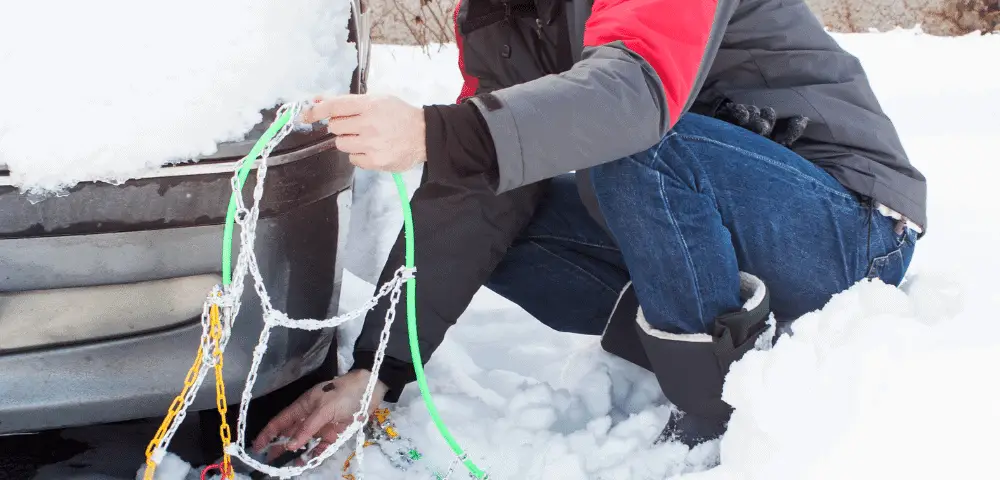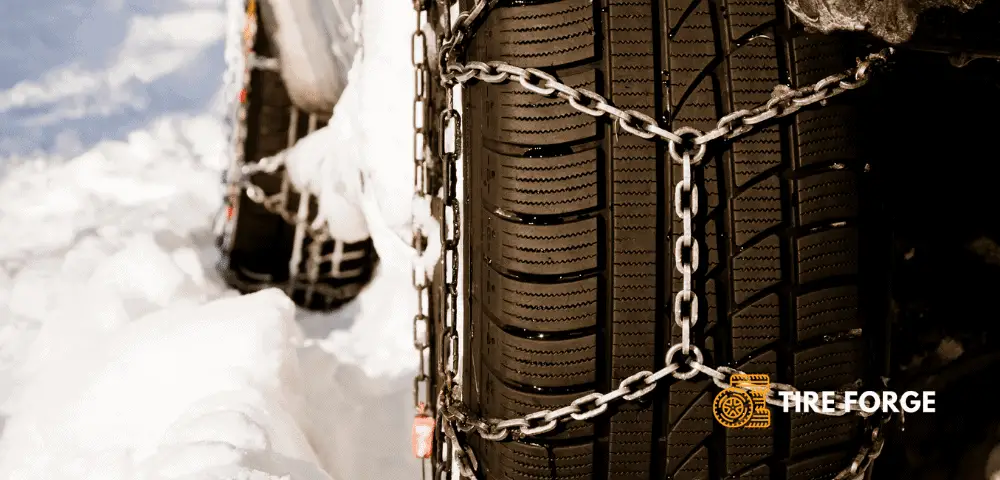Tire chains are a necessity in cold and hilly regions where even the best of snow tires fail to grip the snow-covered roads. Not only in snowy regions but many areas with challenging slippery terrain also require tire chains.
The tire chains help grip the road by clawing onto the ice, mud, or snow-covered tarmac, and by doing so, the vehicle gains forward momentum.
Without a tire chain, the vehicle would spin its wheels without moving forward.
In some snowy regions of the north, it is mandatory by law to have snow chains in the vehicle in case the weather turns extreme.
What makes up a tire chain?
A tire chain isn’t just a simple chain that goes around the tires. It consists of a side chain, a cross-chain, and tire links for the entire setup to work properly.
1. Sidechain
The Sidechain or, the link chain helps connect the links and the cross-chain. It forms the framework of the entire tire chain.
2. Cross chain
The cross-chain goes around the tire and looks very different from a typical chain. That is because the cross chain’s job is to provide traction so the vehicle can move forward. The cross-chain comes in contact with the tire and road.
3. Links
Links are the blocks that make up the cross-chain. These individual pieces connect to make a cross-chain.
A link is designed to grip the road and the tire to enable traction on icy/ snowy roads. Links can be studded links, V-Bar links, or net links based on the size of the vehicle and nature of use.
How do I know what tire chains I need?
Using the correct size tire chains is the key to making them work properly. However, one must first check if tire chains can be used on their vehicle.
If there are restrictions on tire chain usage, it could be indicative of a reduced space between the tires and the vehicle body. In such instances, the usage of tire chains is not recommended.
Tire Sizes
Take a look at your old tires to determine the correct size. The image shown in this example indicates your tire’s specs as well as what they mean.

- P — Tire type
- 245 — Tire width in millimeters
- 75 — Sidewall height to width aspect ratio
- R — Tire construction
- 17 — Wheel diameter in inches
1. Tire width
Tire width can be known by checking the sidewall of the tire. Manufacturers offer all the information about tire sizes and the specification. For the measurements, one could find a fraction number on the tire wall in large font.
For example, if the size of a tire is 185/70- 15. The numerator factor of the fraction in this case, which is 185 is the width of the tire in millimeters.
2. Aspect ratio
The aspect ratio is the ratio of the overall ratio of the height of the sidewall compared to the width. The higher the number, the thicker the sidewall of a tire is and vice versa.
This information can be found in the same fraction number as mentioned earlier.
For example, if the size of a tire is 185/70- 15. The denominator factor of the fraction in this case, which is 70, is the aspect ratio of the tire in millimeters.
3. Wheel Diameter
The wheel diameter can be termed as the length of an imaginary straight line that passes through the wheel from one end to the other.
This information too can be found on the sidewall of a tire. It is crucial to know the diameter when buying snow chains.
For example, if the size of a tire is 185/70- 15. Number 15 in this case is the diameter of the wheel in inches.
One needs the tire width, aspect ratio, and wheel diameter information to choose snow chains of the correct size.
4. Car Type
Sometimes, the type of vehicle can also influence the tire chain’s compatibility. If the car is a medium-sized sedan, it may need chain links of a particular kind to tackle ice, mud, or snow.
On the other hand though, if the vehicle in question is a large heavy pickup truck that finds itself often on hilly unpaved terrain in winters.
Then a different type of snow chain with suitable links would be compatible as compared to the tire chains for a medium-sized sedan.
Choosing Compatible Tire Chains
While it is important to choose the right size tire chain, one should also ensure the kind of activity the tire chain is used for.
Tire chains come for many applications and a variety of vehicles, hence one must choose the right tire chain.
To go a little deeper, tire chains can differ from vehicle to vehicle despite the size remaining the same. An off-roader would need a different type of tire chain when compared to a small hatchback that performs city duties.
On the other hand, the purpose of the task and terrain the tire chains are going to be used for also make a huge difference.
There are specific tire chains for deep snow driving, for driving on icy roads, chains for mud use, chains for light snow driving, etc.
We suggest one determines the tire size of their vehicle, the application for vehicle use, and the kind of terrain the vehicle would be used on. These details would help in choosing the right tire chains.
Do tire chains have to be of an exact size?
Yes, we suggest the tire chains be of the same size as the tires so that they fit perfectly.
A loose tire chain may easily come off and be ineffective. On the other hand, a tight tire chain could easily break or snap off under stress.
Tire chains of the exact size prove to be more reliable over time. Since they are used in extreme conditions, incorrect sized tire chains could lead to one being stranded in extreme conditions, sometimes even in remote areas.
Installing Tire Chains

Step 1: Lay Out Tire Chains, Tines Facing Up
Lay the chains entirely next to the wheels that receive engine power/ drive. Ensure that the parking brake is engaged.
The Tines on the chain must face upwards. You may then drape the chains on the wheels with caution and precision until 3/4th of the tire is covered.
Tuck the ends of the chain under the tire.
Step 2: Connect & Join Both Ends
Drive forward by about two feet to bring the tucked part of the chain on top. Ensure the links are in place. Connect and join both ends of the chain using the anchor system.
Step 3: Expect Chains for Broken Links or Tangles
Inspect to ensure that the chain is evenly installed and is tightened from all sides. Even alignment along the sidewall and a snug fit is key to installing the chains properly. Make necessary adjustments after inspection.
Step 4: Tighten for Snug Fit
Drive for about 100- 150 feet and then stop again to inspect the chains. This should give you an idea of how tight the chains are. If found loose, they need to be tightened.
Once the corrections are done, the vehicle can be driven with the chains under specified speed limits.
Front-wheel or rear wheel?
Ideally, the wheels that get the drive from the engine need to be chained since they would require the most amount of traction. If the vehicle is an all-wheel-drive vehicle, all four wheels can be chained.
Final Thoughts
While choosing the right chain in terms of size and function isn’t rocket science, one needs to be careful in making the correct purchase decision to be worry-free in difficult situations, and for that, it is important to have the correct size tire chains.



